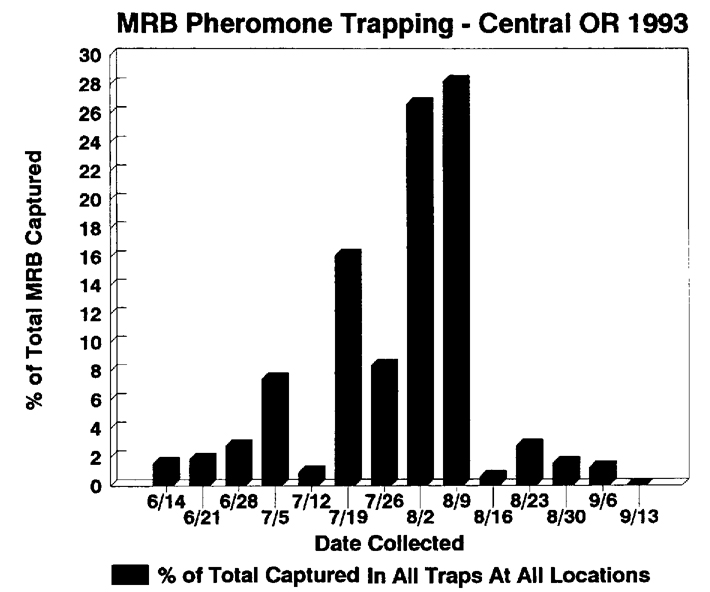 |
Pheromone Trapping for Mint Root Borer |
|
| CONTENTS
Return to:
|
Progress Report - 1993 Marvin Butler, OSU, Extension Crop Scientist Ralph E. Berry, OSU, Department of Entomology Cathie Bennett, Bennett Scouting Service Note: this information is considered unpublished work and should not be used as final or finished results. It has been included in IPMP3.0 because it may not be available from other sources, and in some cases may include information that may not reach final publication. Monitoring Adult Mint Root Borer with Sex Pheromone Traps in Central Oregon The mint root borer (MRB) is a common pest in many mint production areas of the Pacific Northwest. Although not historically reported in central Oregon, the borer was documented in the Lower Bridge area during the 1991 season. Pheromone traps, which emit a scent that attracts male moths, were used during the 1992 season to determine the extent of the borers' distribution in central Oregon. In addition to Lower Bridge, their presence was documented 1992 at Powell Butte, Prineville, Lone Pine, Culver, and Little Agency Plains. Although no borers were found in traps on the Agency Plains and at Gateway, their presence throughout all areas of central Oregon was suspected. Moth numbers in all traps were relatively low in 1992 compared to other mint production areas. It is believed that the mint root borer has been in central Oregon at low levels for an extended period, rather than just in an area experiencing recent outbreaks. In 1992, peak male moth collection occurred on July 23rd. The first males were captured July 13th and no males were captured after August 13th. The objective of the 1993 project was to determine if the timing of emergence differed with climatic variablilty in central Oregon. Twenty-five pheromone traps were placed in 17 fields located at Lower Bridge, Prineville, Lone Pine, Culver, Agency Plains and Little Agency Plains on June 3, 1993. Six traps were located at Lower Bridge, five near Prineville, two at Lone Pine, six in the Culver area, four on Agency Plaints, and two on Little Agency Plains. Traps were checked weekly from June 14 to September 13, when the last traps were removed from the fields. The results are shown in the figure below. Male mint root borers were collected at all trap locations. The overall peak of males captured occurred during the weeks ending August 2 and August 9, with the last moths collected on September 6. This compares to a peak during the week ending July 23 in 1992. A later peak was expected for the 1993 season due to cool spring and summer weather. Results of research conducted by Joyce Takayasu did not show a correlation between male moth counts in pheromone traps and larval numbers in the field in August and September. Therefore, pheromone trapping should be used only as an indicator of the presence of mint root borer, and field sampling is necessary to determine if treatable levels of larvae are present in the fall. Also see Berry et al. 1991b and Berry et al. 1993.  |